-
01
Sep
LTL Shipment Dimensions – How to prove yours are right

What are the correct dimensions (length, width, and height) of the LTL shipment above? Was the length really 46.5 inches? Was the height really 80.5 inches? How does that tilted carton factor into the equation? We will cover that topic, and more, in the article below.In our last blog post we talked about why LTL shippers and logistics providers want to make capture of accurate shipment dimensions on the bill of Lading part of your SOP. Here is a recap of the many benefits you get from having accurate shipment dimensions:
- You should know more about your freight profile than your carriers. Trust me, they are learning more each day. Information is power.
- You can minimize reclasses and other painful freight bill corrections
- You can minimize the impact of surprise rules applications like density minimum, extreme length, and linear foot charges.
- You can ensure you are getting an honest and fair price.
- You can accurately apply freight costs to your products with minimal cross-subsidization
- Dimensional data helps you best defend reclasses and other freight bill corrections (more on this below!)
- You become more valuable to the carrier as you are providing them with information they need. You are becoming more of a shipper of choice.
- You are best prepared in the event you feel a change in service provider or a sourcing event is warranted.
OK, so you have invested time and effort to capture high-accurate dimensions at the individual handling unit level, and you are putting these dimensions on your BOLs. But the LTL carrier has still reclassed your shipment! So what do you do when your LTL carrier reclasses your freight in conflict with the accurate dimensions you provided them on the BOL? How do you prove your dimensions are correct?
Step One is to verify that the dimensions you provided on the BOL are indeed accurate, with no typos, down to the individual handling unit level, that the class and NMF item-sub provided is correct, and finally that the weight is also correct. This seems elementary, but in some cases the carrier may have agreed with your dimensions, but not with your class or weight.
Having your own accurate dims, listed on the BOL, is more than half the battle. It shows you are committed to providing your carrier with the accurate data they need to bill and cost your freight. It gives you real information for which to make an argument other than just stating the reclass is wrong.
Step Two is determining if this reclass is an isolated incident, or is part of a pattern. If an isolated incident, you can further defend your dimensions by noting other reclasses are very rare or non-existent. And if the reclass is part of a pattern, you have more data points to review which should help quantify the real cause of the reclass.
Step Three is to verify exactly what reclass change was made. Did the carrier change the sub on a density-based NMF item? Did they make another type of NMF item change that is not directly tied to the dimensions? Did they apply a rule such as Item 680 (the 65% rule) or Item 640 (mixed commodity rule). It might be that they came up with a different set of dimensions than yours, but the dimensions are really not the basis for the reclass.
Step Four is to review all of the documentation provided by the carrier that supports their reclass. Carriers should at the least provide an inspection or dimensioning certificate that documents the dimensions they found. Further, carriers should also have photographs of your shipment proving the measured the right one. While not all carriers will post these photos to their website, they should have these photos. The photo here shows an actual LTL shipment that the carrier’s dimensioner showed to be 46.5” long by 50.0” wide by 80.5” tall. But you can also see that, due to carton shift or some other movement, one of the cartons is leaning. This is adding several inches to two of the dimensions. Other cartons appear to have shifted as well. Both the shipper and the pickup driver noted the same dimensions of 41.0” by 50.0” by 77.0”. Based upon the 3 sources of dimensions plus the photo, the carrier removed their reclass and restored the original charges.
Many carriers also have CCTV camera systems on their docks which help with things like documenting damage and locating lost shipments. These systems can also help visually validate dimensions to some extent. While they can be used for high accuracy, they can for example tell if a pallet is 24” or 72” tall.
The final point to make is that putting accurate shipment dimensions on the BOL should help protect you from minor dimensional differences. Let’s say the carrier came up with a height that was 1 inch taller than your height, and they reclassed the shipment based upon this very small difference. Even if you cannot agree on what the correct height truly was, you can make the point that you are doing your part to provide accurate dimensions. Absent any recurring issues, the carrier should be willing to give you a small grace window to ensure you continue providing these dimensions.
- (479) 461-1672
- Contact Us
